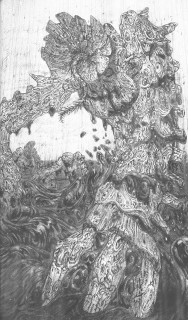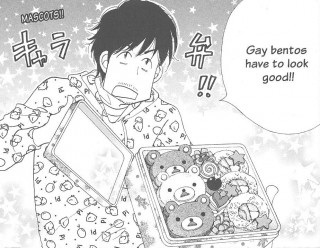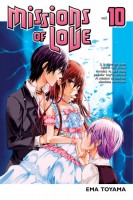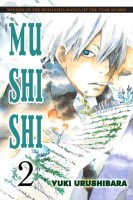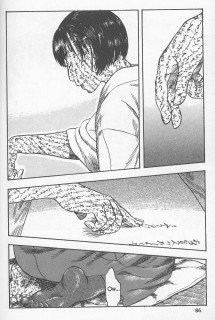My News and Reviews
Two more reviews were posted at Experiments in Manga last week. Only one was of a manga, but the other book does include illustrations! I’m a little behind in reviewing the series, but I finally wrote up my impressions of Fumi Yoshinaga’s What Did You Eat Yesterday?, Volume 6. (Just in time for the seventh volume to be released later this week!) There’s some really nice character development for Shiro and, as always, delicious-looking food. The second review posted last week was for Haikasoru’s anthology of short fiction Phantasm Japan: Fantasies Light and Dark from and about Japan which collects twenty-one horror-tinged stories. It has a great range of contributions and authors and is an excellent followup to the The Future Is Japanese anthology.
I’ve been busy at work and the taiko performance season is ramping up, so I’ve not had much time to pay attention to the manga news over the last week or so. (Let me know if I missed something good!) However, I did see that Manga Brog posted a translation of interviews of Inio Asano and Daisuke Igarashi from the magazine Manga Erotics F in 2012. And speaking of Asano, Vertical Comics apparently made a license announcement a couple of weekends ago—an omnibus edition of Asano’s A Girl on the Shore. Asano’s Nijigahara Holograph left a huge impression on me last year, so I’m really looking forward to reading more of his work in English.
Quick Takes
 Attack on Titan, Volume 14 by Hajime Isayama. The cover of the fourteenth volume of Attack on Titan has a Western flair to it (“Western” as in the genre) and, surprisingly enough, so do the contents. I found the introduction of the trappings of the American Old West to be a little bizarre in a setting that has largely been European-influenced, but it is what it is. I never expected there to be a guns-blazing saloon shootout in Attack on Titan, but it is an admittedly exciting scene even if it does feel a little out-of-place. Also somewhat surprising, not a single Titan makes an appearance in the volume except for flashbacks. The series’ focus has shifted from the fight against the Titans to the conflict inside of the walls as humans are pitted against each other. The Survey Corps is in the process of trying to reveal some major conspiracies to the general public, schemes that the Military Police and government would rather not come to light, so things get pretty violent. All in all, even considering the odd Western elements, it’s an excellent volume of Attack on Titan with some great action sequences, character development, and plot progression.
Attack on Titan, Volume 14 by Hajime Isayama. The cover of the fourteenth volume of Attack on Titan has a Western flair to it (“Western” as in the genre) and, surprisingly enough, so do the contents. I found the introduction of the trappings of the American Old West to be a little bizarre in a setting that has largely been European-influenced, but it is what it is. I never expected there to be a guns-blazing saloon shootout in Attack on Titan, but it is an admittedly exciting scene even if it does feel a little out-of-place. Also somewhat surprising, not a single Titan makes an appearance in the volume except for flashbacks. The series’ focus has shifted from the fight against the Titans to the conflict inside of the walls as humans are pitted against each other. The Survey Corps is in the process of trying to reveal some major conspiracies to the general public, schemes that the Military Police and government would rather not come to light, so things get pretty violent. All in all, even considering the odd Western elements, it’s an excellent volume of Attack on Titan with some great action sequences, character development, and plot progression.
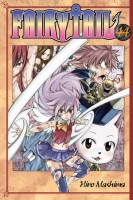 Fairy Tail, Volumes 44-46 by Hiro Mashima. The Tartaros arc of Fairy Tail continues with these three volumes of the series. Fairy Tail is facing off with a guild of demons which is attempting to eliminate all magic except for its own curses. For the most part, it’s battle after battle without too much story development. Major sacrifices are made by Fairy Tail (sadly, some of them lose their significance and impact when Mashima doesn’t completely follow through with them), and a new antagonist is introduced, the extremely powerful King of the Underworld, Mard Geer. Reading Mashima’s afterwords at the end of each volume, it seems as though he has tried to carefully plan out the important events and battles of Fairy Tail. Even so, it feels as though the series meanders getting from one major plot point to the next, almost as if Mashima is making the story up as he goes instead of having a definite endpoint in mind. However, the fights can be exciting and the characters continue to evolve, or at least power up. I was pleased to see the forty-sixth volume turn the manga’s focus back onto Gray, though, bringing his most recent story arc to a satisfying conclusion.
Fairy Tail, Volumes 44-46 by Hiro Mashima. The Tartaros arc of Fairy Tail continues with these three volumes of the series. Fairy Tail is facing off with a guild of demons which is attempting to eliminate all magic except for its own curses. For the most part, it’s battle after battle without too much story development. Major sacrifices are made by Fairy Tail (sadly, some of them lose their significance and impact when Mashima doesn’t completely follow through with them), and a new antagonist is introduced, the extremely powerful King of the Underworld, Mard Geer. Reading Mashima’s afterwords at the end of each volume, it seems as though he has tried to carefully plan out the important events and battles of Fairy Tail. Even so, it feels as though the series meanders getting from one major plot point to the next, almost as if Mashima is making the story up as he goes instead of having a definite endpoint in mind. However, the fights can be exciting and the characters continue to evolve, or at least power up. I was pleased to see the forty-sixth volume turn the manga’s focus back onto Gray, though, bringing his most recent story arc to a satisfying conclusion.
 Sankarea: Undying Love, Volume 10 by Mitsuru Hattori. There have been parts of Sankarea that I’ve really enjoyed, and parts of the series that I really have not, but overall the tenth volume frustrates me more than anything else. Mostly it’s because of the narrative structure and the fact that several important backstories are crammed into the volume. I almost wonder if Hattori realized that he was running out of time to bring the series to a proper conclusion. (There is only one more volume after this one.) It is good to finally find out more about Chihiro’s grandfather and all of his research into bringing the living back to life. And there are some great horror elements to that particular story, as well. I just really wish the revelation hadn’t taken the form of a huge infodump given by a conveniently revived zombie. However, I did like the different art styles that Hattori used to distinguish Chihiro’s memories of his mother and the story about Chihiro’s grandfather from the rest of the manga. And I am curious to see how Sankarea will end. It’s been a strange if somewhat uneven series about zombies and love, part horror manga and part romantic comedy.
Sankarea: Undying Love, Volume 10 by Mitsuru Hattori. There have been parts of Sankarea that I’ve really enjoyed, and parts of the series that I really have not, but overall the tenth volume frustrates me more than anything else. Mostly it’s because of the narrative structure and the fact that several important backstories are crammed into the volume. I almost wonder if Hattori realized that he was running out of time to bring the series to a proper conclusion. (There is only one more volume after this one.) It is good to finally find out more about Chihiro’s grandfather and all of his research into bringing the living back to life. And there are some great horror elements to that particular story, as well. I just really wish the revelation hadn’t taken the form of a huge infodump given by a conveniently revived zombie. However, I did like the different art styles that Hattori used to distinguish Chihiro’s memories of his mother and the story about Chihiro’s grandfather from the rest of the manga. And I am curious to see how Sankarea will end. It’s been a strange if somewhat uneven series about zombies and love, part horror manga and part romantic comedy.


